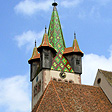ST DIDIER CHURCH AVIGNON
Gothic Collegiate Church of Provence
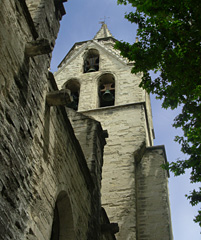 The former Collegial Church of Saint-Didier in Avignon,Collegiate Monastery Church of Saint-Didier (St. Desiderius ) is a early Gothic church in the old town of Avignon, named for Desiderius of Langres. Also known as Desiderious of Genoa, he was an Italian made the Bishop of Langres, a town in the modern Haut-Marne district of Northen France, by the Acts of the Council of Serdica in the year 343. He was beheaded at Langres by Vandal invaders who had crossed the Roman Limes into Gaul in the 3rd and 4th Centuries (see Romans Limes) in 356. The legend is he marched out to greet the hordes to negotiate to save the city, but he was slaughtered on the spot. The Vandals were not so good at negotiating, which is where vandalism comes from.
The former Collegial Church of Saint-Didier in Avignon,Collegiate Monastery Church of Saint-Didier (St. Desiderius ) is a early Gothic church in the old town of Avignon, named for Desiderius of Langres. Also known as Desiderious of Genoa, he was an Italian made the Bishop of Langres, a town in the modern Haut-Marne district of Northen France, by the Acts of the Council of Serdica in the year 343. He was beheaded at Langres by Vandal invaders who had crossed the Roman Limes into Gaul in the 3rd and 4th Centuries (see Romans Limes) in 356. The legend is he marched out to greet the hordes to negotiate to save the city, but he was slaughtered on the spot. The Vandals were not so good at negotiating, which is where vandalism comes from.
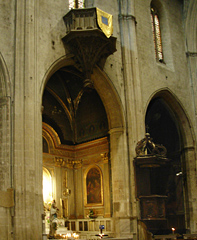 The church, part of the collegiate monastery of Avignon named for him began construction a thousand years from his martydom, was consecrated on the 20th of September, 1356. It replaced an earlier building which no longer fit the status of Avignon as the Papal city, built with funds from an endowment from the estate of the Cardinal Bertrand de Deaux as a place for his burial after his death in October of 1355.
The church, part of the collegiate monastery of Avignon named for him began construction a thousand years from his martydom, was consecrated on the 20th of September, 1356. It replaced an earlier building which no longer fit the status of Avignon as the Papal city, built with funds from an endowment from the estate of the Cardinal Bertrand de Deaux as a place for his burial after his death in October of 1355.
Bertrand of Déaux had risen from a church lawyer to Apostolic Legate and eventually made a Cardinal in 1348. He was named to the conclave of Cardinals to the elect the successor of Clement VI who died in the Avignon Palace on December 6, of 1352, the Feast of St. Nicholas. It took three days to name Cardinal Étienne Aubert of Limoges as Pope Innocent VI.
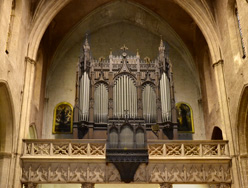 The chief architect was Jacques Alasaud, who had been one of the principal forces in the construction of the Palace of the Popes in Avignon. The form of the St Didier Church is a little unusual in the flat and square form, with no transcepts, rather than the high arch flying buttress styles of other Gothic constructions of the time, called the Meridional Gothic style which was prominent in southern France, with limited decoration, influenced by the Cistercians. The most impressive exterior feature of the church is the massive square bell tower which dominates Saint Didier Square.
The chief architect was Jacques Alasaud, who had been one of the principal forces in the construction of the Palace of the Popes in Avignon. The form of the St Didier Church is a little unusual in the flat and square form, with no transcepts, rather than the high arch flying buttress styles of other Gothic constructions of the time, called the Meridional Gothic style which was prominent in southern France, with limited decoration, influenced by the Cistercians. The most impressive exterior feature of the church is the massive square bell tower which dominates Saint Didier Square.
The nave of the church spans an elaborate cross-ribbed vaulted ceiling with small stained-glass windows and chapels on either side, while the eastern end consists of a polygonal shaped choir with a high altar. From the original decoration art of the church only parts of wall paintings with representations of the Passions have survived.
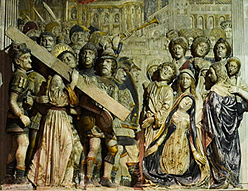 A rare altar piece of sandstone of Christ carrying the cross surrounded by a crowd of accompanying figures in relief, is one of the earliest examples of Renaissance art in France, created around 1480 by Francesco Laurana in honor of René of Anjou, Count of Provence and King of Naples. An organ was added in a Gothic Revival in 1891 built by the organ builder François Mader housed in a neo-gothic casing for the pipes.
A rare altar piece of sandstone of Christ carrying the cross surrounded by a crowd of accompanying figures in relief, is one of the earliest examples of Renaissance art in France, created around 1480 by Francesco Laurana in honor of René of Anjou, Count of Provence and King of Naples. An organ was added in a Gothic Revival in 1891 built by the organ builder François Mader housed in a neo-gothic casing for the pipes.
Relics of Saint Bénézet and Saint Pierre de Luxembourg
The church holds some treasures including relics of Saint Bénézet, rather the Tom Sawyer of his day. As the story goes, he was a shepherd boy who saw a vision to build a bridge over the Rhone River. No-one wanted to help him, so he lifted the first great stone by himself. Suddenly, blind could see, deaf could hear and lame could walk. Impressed by 18 miracles, wealthy sponsors formed the Bridge Brotherhood to build the bridge to Avignon, the Pont Saint-Bénézet. His bones were moved to St Didier after part of the bridge, where he was originally interred, was washed away in 1669.
Also here are relics of Saint Peter (Pierre) of Luxembourg, another boy prodigy, who at the age of ten was made a Canon of Notre Dame de Paris (see Notre Dame Cathedral) and raised to Bishop of Metz at just the age of fifteen by the AntiPope Clement VII (see Metz St Stephen Cathedral). He held it only a short while with troops until forced to flee by the forces of Holy Roman Emperor Charles IV who supported Pope Urban VI. Peter died at only eighteen of what we would now call anorexia. He fasted himself to death. He wanted to be buried in a pauper‘s grave, but when miracles started to happen over the spot, he was dug up and beatified. His bones were also moved, orginally held at the Sainte-Chapelle in Paris, but destroyed during French Revolution, scattered on a garbage heap when possessions of the king were outlawed, but what remained was collected and removed to Avignon. © Bargain Travel Europe
Find best travel and hotel deals in Provence at TripAdvisor
Web Info
Avignon Tourism
These articles are copyrighted and the sole property of Bargain Travel Europe and WLPV, LLC. and may not be copied or reprinted without permission.
See Also:
ROMAN AMPHITHEATER ORANGE PROVENCE
LE LUBERON HOTEL RESTAURANT PROVENCE
CHATEAU DES BAUX CASTLE RUINS IN PROVENCE
CHATEAU
L'AUBERGE BERNE PROVENCE

